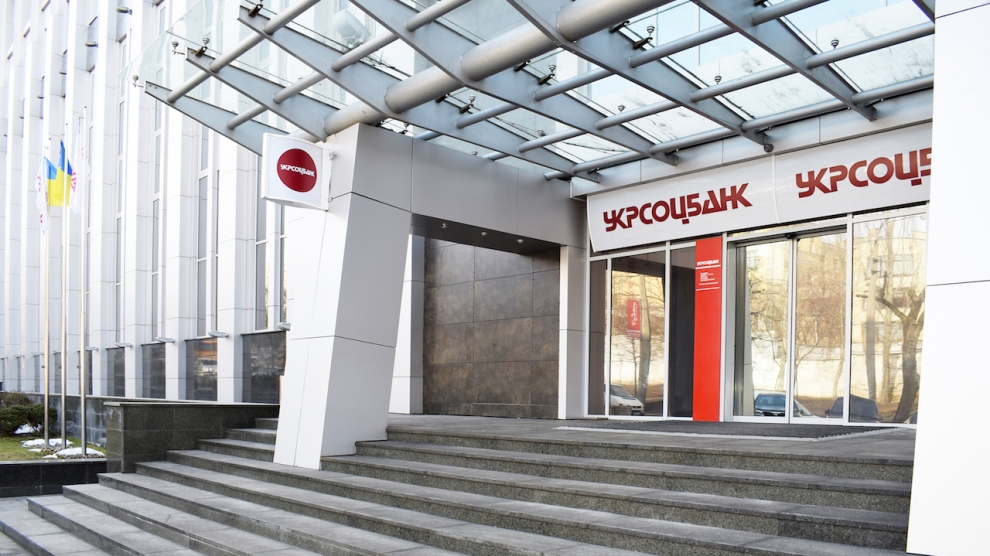The Ukrainian banking sector is going through tremendous changes. The National Bank’s efforts to clean up the industry, the recent nationalisation of PrivatBank and the merger of Ukrsotsbank and Alfa-Bank are only a few examples.
Tamara Savoshchenko, Chairwoman of the Management Board at Ukrsotsbank, and Roman Shpek, an advisor to the President of Alfa-Bank Ukraine and Head of the Independent Association of Ukrainian Banks, spoke to Andrew Wrobel about the bank’s merger and its impact on the market as well as the prospects for the banking sector in Ukraine.
Ukrsotsbank has been in the market since 1990, but its history is very much linked to Pekao and UniCredit, which means the bank has a background of international experience. How does this help the bank to operate?

Tamara Savoshchenko: It is true. Ukrsotsbank’s history spans back, practically to the USSR: We are one of the oldest banks in the country. In September 2017, we are going to celebrate the bank’s 27th anniversary, which is an unrivalled marker for the local market.
Needless to say, our ten years within one of the largest European banking groups has left us with a collection of experience, a rich corporate culture and the reputation of being a true international brand. The good thing is that now, as the deal with Alfa-Group is closed, we can combine the global experience of our two groups. The challenge in our hands now, is to take what’s best in the practices of UniCredit and Alfa and find a proper synergy to use as a cornerstone for building ourselves into a market leader, both in terms of size, technologies and quality of service.
Speaking about UniCredit; the bank was sold to ABH Holding at the end of October 2016. What will be the consequences of that transaction?
Roman Shpek: This deal was a milestone for the whole financial market of Ukraine and was dubbed “The Deal of the Year”. As you know, the deal prescribes that 99.9 per cent of Ukrsotsbank should be transferred from UniCredit Group to ABH Holdings S.A. (ABHH) in exchange for a minority 9.9 per cent stake in ABHH. Once it was completed, in October 2016, Ukrsotsbank announced the return of its historic brand.
Globally speaking, the deal will have a positive influence on the financial market and the economy in general, as noted by both the National Bank and the Anti-Monopoly Committee. I would also add that this deal was a much needed positive signal for international investors, demonstrating the possibility to do banking here and stimulating their desire to develop business in Ukraine.
What is the bank’s current market share and how do you see that growing in the next year?
Tamara Savoshchenko: I would rather concentrate on the combined share of Ukrsotsbank and Alfa-Bank, for that’s the way we look at it. In terms of assets, we cover 7 per cent of the market, commanding a 17.5 per cent market share in terms of capital; we give 22.8 per cent of loans to individuals and 6.6 per cent of loans to legal entities. In terms of deposits we hold 7 per cent and 5.7 per cent of the market for individuals and legal entities, respectively.
We also have 4.3 per cent of the country’s POS terminals, having issued 5.1 per cent of all payment cards in the country. It is a very competitive share and we expect it to grow even further, because clients tend to migrate to stronger international banks that have the full support of their shareholders and no inherent political risks.
We are touching on the banking sector in Ukraine now. It has gone through significant changes recently, especially in December when the country’s biggest bank was nationalised. How do you see the changes from your bank’s perspective?
Tamara Savoshchenko: The banking sector is still far enough from the state that one could say it is “healthy and growing again”. However, 2016 was a turning point for the sector. The biggest banks have been proceeding with their business restructuring and capital increase programmes, and many of them climbed out of the red back, returning to positive financial results.

Roman Shpek: The issue of PrivatBank was a big worrisome blot on the radar throughout all the year, and the resolution of this issue, by the government in December, went rather smoothly. This alleviated a lot of risks for the sector.
General market conditions have also improved, with macro financial stability restored and the economy returning to growth. Some 2 per cent growth in real GDP over 2016 was shown, which is still modest, but it is finally positive after several years of recession. Despite some problems still existing at some banks, we saw deposits returning to the sector. In 2016, deposits in Ukraine’s banks increased 5 per cent in real terms, after an accumulated outflow of 30 per cent over 2014-2015.
When I spoke to Dmytro Sologub, he talked about “a mess” in the banking sector that the National Bank is putting in order. What is your perspective on the sector?
Tamara Savoshchenko: Now, we can see that most of the big banks have passed the “stress tests” and continue operating on the market. Those banks where shareholders could not, or did not want to, cover their losses went under and are now out of the market. The central bank made a tremendous effort, handling not only the latest banking crisis, but also all the issues that have been accumulating in the sector over the last ten years.
After nationalising Privatbank and removing several troublesome second-tier banks (Fidobank, Mykhailivskyi, and Platinum) from the market, the process of market cleansing that is going on at the start of 2017 seems to be close to the finish line. Only small banks, which account for some 3 per cent of the market, remain to be dealt with; however, any developments that involve them should not have any material impact on the market generally.

Roman Shpek: The market cleansing that happened was necessary to restore its health. The failed financial institutions had been spreading toxic waves all over the market, filling the mass media with stories of frozen deposits and discouraging shareholders of other banks from injecting additional capital, a very hard decision, especially for foreign-owned banks.
Nevertheless, despite the ranks of Ukraine’s banks having more than halved, we see that market competition on the market remains very tough. The number of bankable clients in Ukraine is limited and a lot of corporate clients are too indebted to be given new loans.
Do you think the Ukrainian banking system enjoys public confidence now?
Tamara Savoshchenko: Of course, some significant losses of deposits in failed banks and the dramatic devaluation of the national currency have not been instrumental in increasing public confidence in the banking sector. At the same time, Ukrainians still have to invest their money, or at least to try to save its value against inflation. With very small, risky and underdeveloped financial markets, there is no real alternative to the banking sector.
The recent macroeconomic stabilisation has helped to restore the public’s confidence. People understand that there have been banks, and there have been safe banks that value their reputation. For instance, in our banking group, Ukrsotsbank and Alfa-Bank have always repaid every cent of deposits, even in the darkest times of 2008-2009 and the 2014-2015 crises.
Do you see any room for mergers and acquisitions? Perhaps involving foreign players?
Roman Shpek: We are a vivid example that shows such deals are possible. The strategic merger of Ukrsotsbank and Alfa-Bank businesses was definitely one the most important events for Ukraine’s banking sector. In is not a big secret that some players explore different exit strategies, so their business is potentially for sale. If all of them were to sell now that would mean accepting a big loss, which is a very hard decision, especially when there are few potential buyers.
Further changes in the market’s structure depend largely on the government’s strategy concerning its holdings. After the Privatbank’s nationalisation, the government now controls more than half of the banking sector. The government has voiced a strategy of privatising non-core assets, so this could be the next big M&A event on the market. Russian state-owned banks also have rather unclear prospects here, so that might be another possible area for M&As.
Let’s change the topic slightly now. How do you see the development of the private sector in Ukraine and its access to funding? Do SMEs have easy access to financing, and what products are on offer?
Roman Shpek: When this crisis began, Ukraine had a ratio of corporate loans to GDP of around 50 per cent, while the ratio of household loans to GDP was 13 per cent. A simple comparison with other countries would suggest that the corporate sector had too much debt, especially when one added any external debt owed by Ukraine’s companies. Now, the ratios are 35 per cent and 7 per cent of GDP respectively: This is mostly because of the fact that about 30 per cent of the total banking sector’s assets have exited the sector due to the failure of so many banks.
Tamara Savoshchenko: The number of bankable clients is limited, due to various reasons. We only consider corporates with reliable financial statements as “bankable clients”. Unfortunately, many companies in Ukraine are operating within an informal shadow economy and they cannot provide reliable consolidated financial statements and neither do they have access to bank lending. In addition, the flawed judicial system increases the risks for banks, especially in large and middle corporate segments.
At the same time, the SME segment has been frequently overlooked by banks. Traditionally, the banks have chased big clients, as they can add a significant piece to the book, and service costs per client are lower. A lot of banks actively went into the retail business servicing households, especially as households have been the core of funding for most of the financial institutions here. So, SMEs have been frequently overlooked: too small and too hard for the corporate, too specific for the retail. We see a rather big potential in the SME sector, but this also needs an improved market infrastructure and regulation, with better credit bureaus, court practices, coverage opportunities, and, last but not least, a better regulatory environment for SMEs in Ukraine.
This being said, we keep coming up with new package offers and overdraft solutions for SMEs, as one of our priority segments. In fact, there’s more to that than just plain old business necessity: the future prospect of Ukraine’s economy depends largely on how the local business evolves. Banks have their role to play in this, so we’ve accepted our share of the responsibility.
We are hearing about very good GDP growth, now, in Q4 2016. However, it is clear that the economy was affected significantly. What impact has this had on consumer demand?
Tamara Savoshchenko: The recovery of the economy, in 2016, was broad-based. Almost every key sector in the economy posted growth last year. Some industries such as agriculture or construction experienced more of an upturn, some were less vibrant and agriculture became the key driver of economy. Rather important for the country and for banks in particular, investment demand surged by a double-digit rate. Stabilisation of the exchange rate and a slowing of inflation stimulated an improvement in business confidence, which helped to resume many CAPEX projects that has previously been frozen in 2014-2015.
We can also see some recovery in household income and consumer demand, despite such strong pressures as the continued large utility tariff hikes. We expect the positive consumer demand trend to continue in 2017, on the back of further growth in household disposable income and moderate inflation.
There is also the devaluation of the hryvnia. How has that impacted the demand?
Tamara Savoshchenko: Dramatically. In most cases, economic aggregates in USD terms fell much harder than in inflation-adjusted real terms. But the economy has adjusted to the new realities. As the FX market goes through this painful adjustment and local demand recovers, there is also a recovery in imports happening for many products, from FMCGs to durable goods to business machinery.
How aware are Ukrainian consumers, today, about banking products: credit cards, consumer loans and mortgages and mobile banking? Do you see prospects for growth in retail banking?
Tamara Savoshchenko: In Ukraine, the volume of card payments increased by a factor of 13 (by 1,200 per cent) in 2015 as compared to 2010. So, the market has demonstrated fantastic growth, despite the economic crisis of 2014-15. The proliferation of gadgets has brought about a reciprocal proliferation of online banking. Banks compete not only with interest rates and offline service but also, more and more, with the scope of their e-banking options. Nevertheless, the abundance of card products still remains lower than in CEE countries, meaning there is still much untapped potential on the market.
The total debt load of households returned back to the level it was in 2005. Low debt load brings potential opportunities for the expansion of retail lending. As for mortgages, the development of the segment is still hindered by unsettled legal issues, in particular by the on-going moratorium on mortgage collateral collection.

Where do you see future growth in the sector?
Tamara Savoshchenko: We expect that the sector will continue to expand cashless payments and to increase its proliferation of online banking. Ukrainian banks will focus on consumer lending and the financing of export-oriented businesses, in particular, agriculture.
A difficult situation can be perceived as either an obstacle or as an opportunity. How do you see it?
Roman Shpek: A difficult economic situation is an obstacle for sure. Ukrainian banks still suffer from a high level of non-performing loans (NPLs). This immense burden of bad debt doesn’t allow Ukrainian banks to expand lending in line with the economic expansion or other fundamentals.
What is important, now, is an improved environment that both prevents NPLs from spreading and allows for an easier resolution of current NPLs. Ukraine desperately needs better commercial courts, new bankruptcy legislation, better tax regulations for write-offs and fewer legal opportunities for borrowers to cheat banks by taking loans they do not intend to pay back. If the state delivers such decisions, the banking sector would recover more quickly and may reinforce the, as yet, slow economic recovery by becoming its major driver.
Tamara Savoshchenko: In the meantime, the economic crisis really stimulates banks to be more mobile, both literally and figuratively. For example, almost all the largest Ukrainian banks now have mobile applications. Ukrainian banks respond more quickly to needs of their consumers and have fewer service costs. Despite the difficult market environment Ukrainian banks invest a lot into their IT infrastructure, which helps to provide clients with a top-notch service.


Our family has had a mortgage with Ukrsotsbank since 2006 in USD. We have paid off more than 76 per cent of the mortgage so far despite more than 500 % of USD exchange rate growth. Besides, 48 per cent of the money borrowed has been paid as interest to the bank. Nowadays, the situation in the family is so desperate that we have addressed the bank to make rearrangement and satisfy the rest debt by our regularly paid interest. Sadly, we are desperately trying to reach top management, none of them replies, there is no real physical possibility to start any kind of negotiations. The bank is locked for customers. I hardly see any visible change towards clients. In the course of 5 weeks after our application, the bank has been keeping away from us. Could you imagine that in any overseas bank after a client arriving at the bank, postal application and electronic claims to a number of top managers? Unfortunately, customer service is much far from being up-market in the bank no matter before the merger or after. I see the poor management. I am really sorry about my country banking business which is one-way strategy one. I l’d rather be mistaken.
How pretty-pretty looks the interview. Ask me – a client of Ukrsotsbank from 2006 with a mortgage in USD. Since then the USD exchange rate to local currency in Ukraine has risen by more than 500%. My family has been paying off until we’ve paid 78% of the loan plus 48% of the loan as the bank interest. Good deal for the bank, isn’t it. These days the situation in Ukraine being quite challenging, our family of 6 members, 2 of whom are children, 2 got unemployed within 3 months, 2 are retired with one of those only working, we are facing the period of surviving. The mortgage seems impossible at the time when municipal charges are more than 60% of the family income. With this desperate fact, we have applied for the bank with the request to satisfy the rest of the debt by the money paid as interest. Guess what happens? We arrived at the bank – no possibility to reach the decision maker, just staying in the lounge of the bank, none of the clients are allowed to get upstairs! None of the written applications, posted and emailed ones, sent to different top managers succeeded to get any reply from top managers. They give interviews rather than talk to customers! It’s nonsense in customer service handling. No actions made for about two months. So, when I read such materials, I am sorry about the lack of practically true info. Neither of the banks has introduced proper strategy into retail services. In terms of corporate offers, I’d also be cautious. Would you expect fair play? Ask me more.